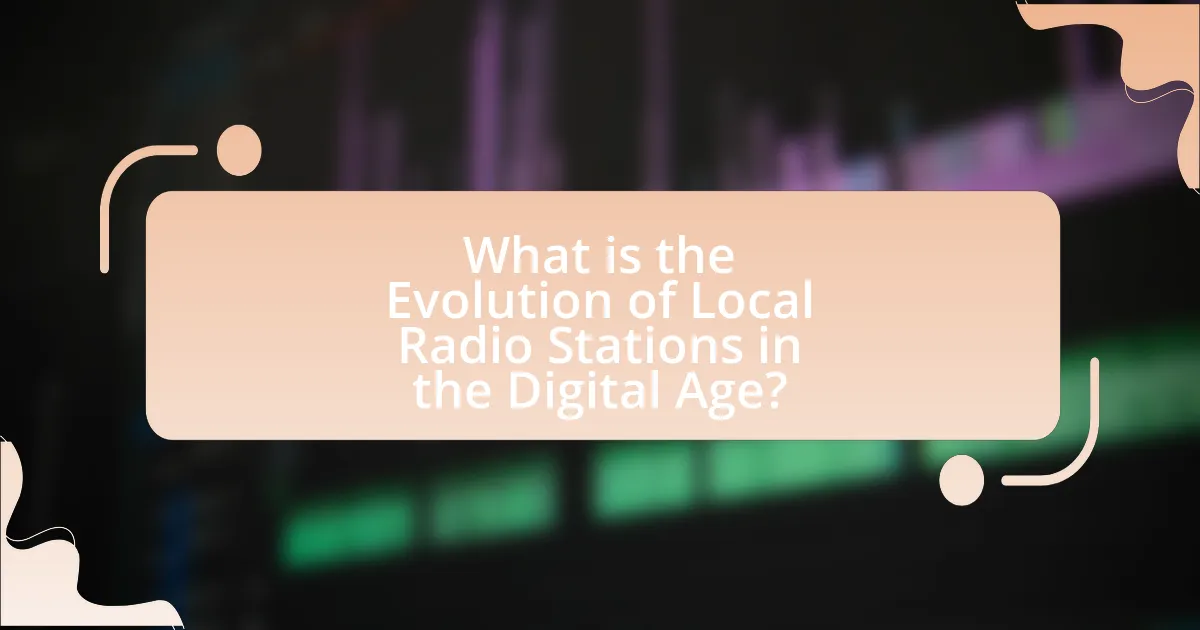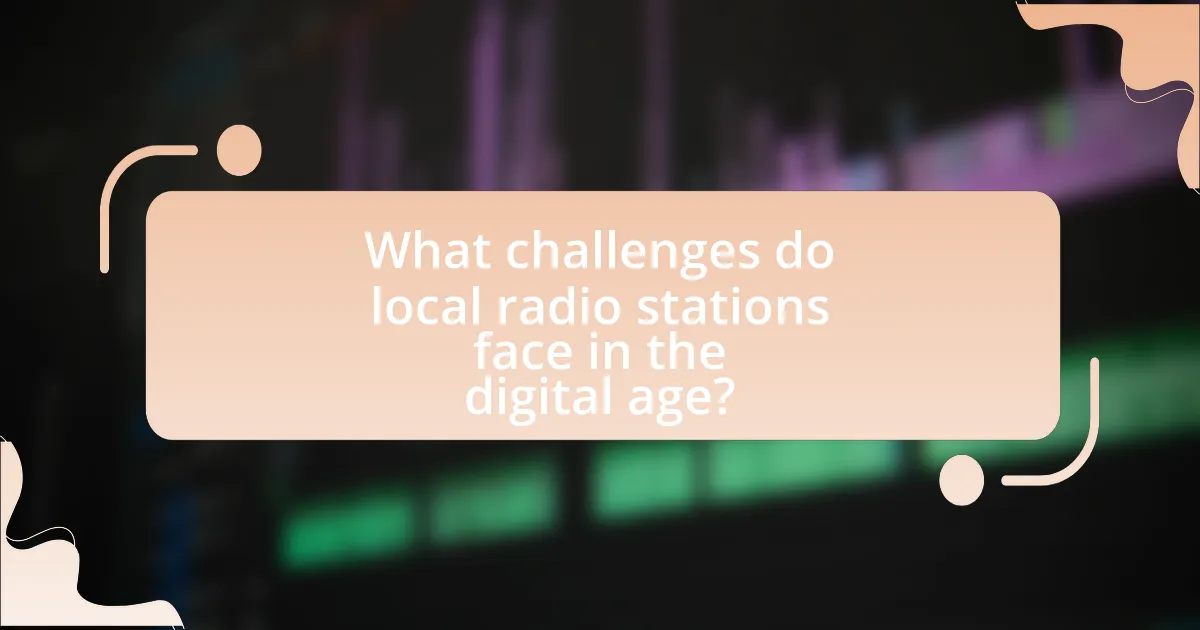The article examines the evolution of local radio stations in the digital age, highlighting their transition from traditional AM and FM broadcasting to digital platforms and technologies. It discusses how local stations have adapted by incorporating online streaming, social media engagement, and mobile applications to expand their audience reach and enhance listener interaction. Key technological advancements, such as digital broadcasting and streaming services, are explored, along with the challenges posed by competition from digital platforms and changing listener habits. The article also addresses the significance of local radio in community engagement and culture, emerging funding models, and innovative strategies for growth in a rapidly evolving media landscape.

What is the Evolution of Local Radio Stations in the Digital Age?
The evolution of local radio stations in the digital age involves their transition from traditional broadcasting to incorporating digital platforms and technologies. Initially, local radio stations primarily relied on AM and FM frequencies to reach their audiences. However, with the advent of the internet and digital streaming, many local stations have expanded their reach by offering online streaming services, allowing listeners to access content globally.
Additionally, local radio stations have embraced social media and mobile applications to engage with their audience, providing real-time updates and interactive content. According to a 2021 report by the Pew Research Center, 61% of Americans listen to online radio, indicating a significant shift in listener habits. This evolution has also led to increased competition from podcasts and streaming services, prompting local stations to innovate their programming and adopt new revenue models, such as digital advertising and subscription services.
How have local radio stations adapted to digital technologies?
Local radio stations have adapted to digital technologies by incorporating online streaming, social media engagement, and mobile applications. These adaptations allow stations to reach broader audiences beyond their traditional broadcast range. For instance, many local stations now offer live streaming on their websites and through platforms like TuneIn, enabling listeners to access content anytime and anywhere. Additionally, social media platforms such as Facebook and Twitter are utilized for real-time interaction with audiences, promoting shows and sharing news updates. According to a 2021 report by the Pew Research Center, 61% of local radio stations have developed mobile apps to enhance listener engagement and provide on-demand content, demonstrating a significant shift towards digital integration in the industry.
What are the key technological advancements impacting local radio?
Key technological advancements impacting local radio include digital broadcasting, streaming services, and mobile applications. Digital broadcasting enhances sound quality and allows for more channels, while streaming services enable local stations to reach a global audience, increasing their listener base. Mobile applications provide listeners with on-the-go access to radio content, fostering greater engagement. According to the Pew Research Center, as of 2021, 41% of Americans reported listening to online radio, highlighting the shift towards digital platforms. These advancements collectively transform how local radio operates and connects with audiences.
How has the internet changed the way local radio stations operate?
The internet has transformed local radio stations by enabling them to stream content online, thereby expanding their audience reach beyond traditional geographic limitations. This shift allows local stations to attract listeners from around the world, increasing their potential advertising revenue and listener engagement. For instance, according to a 2021 report by the Pew Research Center, 41% of Americans listen to online radio, highlighting the growing trend of digital consumption. Additionally, local radio stations now utilize social media platforms for real-time interaction with their audience, enhancing community engagement and feedback. This integration of internet technology has fundamentally altered operational strategies, making local radio more accessible and interactive.
Why is the evolution of local radio stations significant?
The evolution of local radio stations is significant because it reflects the adaptation of media to changing technology and audience preferences. As digital platforms emerged, local radio stations transitioned from traditional broadcasting to online streaming, allowing them to reach wider audiences and engage listeners through interactive content. This shift is evidenced by the increase in internet radio listenership, which grew from 25% of the U.S. population in 2013 to over 50% in 2021, according to the Nielsen Audio’s “State of Listening” report. Furthermore, local stations have become vital in providing community-specific news and fostering local culture, which enhances their relevance in an increasingly globalized media landscape.
What role do local radio stations play in community engagement?
Local radio stations serve as vital platforms for community engagement by providing localized content that reflects the interests and needs of their audiences. They facilitate communication among residents, promote local events, and offer a space for public discourse, thereby fostering a sense of community identity. According to a study by the Pew Research Center, 75% of local radio listeners feel more connected to their community due to the information and resources provided by these stations. This connection is further enhanced through interactive programming, where listeners can call in, participate in discussions, and share their perspectives, reinforcing the role of local radio as a community hub.
How do local radio stations contribute to local culture and identity?
Local radio stations significantly contribute to local culture and identity by providing a platform for community voices, local news, and cultural programming. They serve as a medium for promoting local artists, events, and traditions, thereby fostering a sense of belonging among residents. For instance, studies show that local radio stations often feature music and content that reflect the unique cultural heritage of their communities, which helps preserve local traditions and languages. Additionally, local radio serves as a vital source of information during emergencies, reinforcing community ties and identity through shared experiences.

What challenges do local radio stations face in the digital age?
Local radio stations face significant challenges in the digital age, primarily due to competition from online streaming services and social media platforms. This competition has led to a decline in traditional listenership, as audiences increasingly prefer on-demand content that digital platforms provide. According to a 2021 Nielsen report, nearly 50% of U.S. adults listen to online radio, highlighting the shift in consumer behavior away from local stations. Additionally, local radio stations struggle with limited advertising revenue, as advertisers are drawn to the broader reach and targeted capabilities of digital platforms. The combination of these factors creates a challenging environment for local radio stations to maintain relevance and financial viability in an evolving media landscape.
How has competition from digital platforms affected local radio?
Competition from digital platforms has significantly diminished the audience and advertising revenue of local radio stations. As listeners increasingly turn to streaming services, podcasts, and social media for content, local radio has struggled to retain its traditional listener base. According to a 2021 Nielsen report, radio’s share of total audio listening dropped to 37%, while digital audio platforms surged to 25%. This shift has forced local radio stations to adapt by enhancing their online presence and diversifying content offerings to compete effectively in the evolving media landscape.
What are the implications of streaming services on local radio listenership?
Streaming services have significantly reduced local radio listenership by providing listeners with a broader range of content options. As of 2023, data indicates that over 80% of Americans use streaming services, which offer personalized playlists and on-demand access to music and podcasts, leading to a decline in traditional radio’s audience. This shift has resulted in local radio stations experiencing decreased advertising revenue and listener engagement, as audiences increasingly prefer the convenience and variety that streaming platforms provide.
How do social media platforms influence local radio station strategies?
Social media platforms significantly influence local radio station strategies by providing new channels for audience engagement and content distribution. Local radio stations utilize social media to promote their programming, interact with listeners in real-time, and gather feedback, which helps tailor their content to audience preferences. For instance, a study by the Pew Research Center in 2021 found that 53% of local radio stations reported using social media to enhance listener interaction, demonstrating its role in shaping programming decisions and marketing strategies. Additionally, social media analytics allow stations to track listener demographics and preferences, enabling them to create targeted content that resonates with their audience.
What financial challenges do local radio stations encounter?
Local radio stations encounter significant financial challenges primarily due to declining advertising revenues. As digital platforms gain popularity, traditional radio faces competition from online streaming services and podcasts, which attract advertisers away from local stations. According to a 2021 report by the Radio Advertising Bureau, local radio ad revenue dropped by 10% from the previous year, highlighting the financial strain on these stations. Additionally, the costs associated with maintaining broadcasting equipment and complying with regulatory requirements further exacerbate their financial difficulties.
How has advertising revenue shifted for local radio stations?
Advertising revenue for local radio stations has significantly declined in recent years. According to the Radio Advertising Bureau, local radio ad revenue dropped from approximately $14.5 billion in 2006 to around $10.5 billion in 2020, reflecting a shift in listener habits and increased competition from digital platforms. This decline is attributed to the rise of streaming services and digital advertising, which have diverted advertising dollars away from traditional radio.
What funding models are emerging for local radio in the digital landscape?
Emerging funding models for local radio in the digital landscape include crowdfunding, subscription-based services, and partnerships with local businesses. Crowdfunding platforms allow listeners to directly support their favorite stations, exemplified by initiatives like Patreon, where fans contribute monthly. Subscription-based models, such as those implemented by some public radio stations, offer exclusive content to paying subscribers, enhancing listener engagement and financial stability. Additionally, partnerships with local businesses provide advertising revenue while fostering community ties, as seen in collaborative promotions and sponsorships. These models reflect a shift towards diversified revenue streams essential for sustainability in the evolving digital environment.

What opportunities exist for local radio stations in the digital age?
Local radio stations have numerous opportunities in the digital age, primarily through online streaming, social media engagement, and targeted advertising. Online streaming allows local stations to reach a global audience, significantly expanding their listener base beyond geographical limitations. Social media platforms enable stations to interact directly with their audience, fostering community engagement and promoting local events. Additionally, targeted advertising through digital platforms allows for more effective marketing strategies, as stations can tailor their content to specific demographics, enhancing revenue potential. According to a report by the Pew Research Center, 61% of Americans listen to online radio, indicating a growing trend that local stations can capitalize on to remain relevant and profitable.
How can local radio stations leverage digital tools for growth?
Local radio stations can leverage digital tools for growth by utilizing social media platforms, streaming services, and targeted online advertising. Social media allows stations to engage with their audience in real-time, promoting shows and events while gathering listener feedback. Streaming services expand their reach beyond traditional broadcast areas, enabling access to a global audience. Targeted online advertising, through platforms like Google Ads and Facebook Ads, allows stations to reach specific demographics, increasing listener engagement and attracting local businesses for sponsorships. According to a 2021 report by the Pew Research Center, 61% of Americans listen to online radio, highlighting the importance of digital presence for growth.
What are the benefits of podcasting for local radio stations?
Podcasting offers local radio stations several benefits, including expanded audience reach, increased engagement, and additional revenue streams. By creating on-demand content, local radio stations can attract listeners beyond their traditional broadcast range, tapping into a global audience. This accessibility allows stations to engage with listeners at their convenience, fostering a deeper connection through tailored content. Furthermore, podcasting can generate new revenue opportunities through sponsorships and advertising, as businesses seek to reach targeted demographics. According to a report by Edison Research, 55% of the U.S. population has listened to a podcast, highlighting the growing popularity and potential for local radio stations to leverage this medium for growth and sustainability.
How can local radio stations utilize social media for audience engagement?
Local radio stations can utilize social media for audience engagement by creating interactive content that encourages listener participation. This includes hosting live Q&A sessions, conducting polls, and sharing behind-the-scenes content that fosters a sense of community. According to a 2021 study by the Pew Research Center, 72% of adults in the U.S. use social media, making it a vital platform for reaching and engaging with a broad audience. By leveraging these platforms, local radio stations can enhance listener loyalty and attract new audiences through targeted promotions and user-generated content.
What innovative strategies are local radio stations adopting?
Local radio stations are adopting innovative strategies such as leveraging digital platforms for streaming and on-demand content, enhancing audience engagement through social media, and utilizing data analytics to tailor programming. These strategies enable stations to reach wider audiences and adapt to changing listener preferences. For instance, according to a 2022 report by the National Association of Broadcasters, over 60% of local radio stations have integrated online streaming services, allowing them to maintain relevance in a competitive media landscape.
How are local radio stations collaborating with other media outlets?
Local radio stations are collaborating with other media outlets through content sharing, joint events, and cross-promotional strategies. For instance, many local radio stations partner with newspapers and online news platforms to share news stories and feature local events, enhancing their reach and audience engagement. Additionally, radio stations often co-host community events with local television stations, which helps to strengthen community ties and increase visibility for both media outlets. This collaboration is supported by the need for diverse content and the ability to leverage each other’s platforms, as evidenced by the rise in joint advertising campaigns that combine radio and digital media to maximize audience impact.
What role does audience feedback play in shaping programming?
Audience feedback plays a crucial role in shaping programming by providing insights into listener preferences and behaviors. This feedback allows radio stations to tailor their content, ensuring it resonates with their audience, which can lead to increased engagement and loyalty. For instance, studies have shown that stations that actively solicit and incorporate listener feedback experience higher ratings and listener satisfaction, demonstrating the direct impact of audience input on programming decisions.
What best practices can local radio stations implement for success?
Local radio stations can implement community engagement, digital presence, and diverse programming as best practices for success. Community engagement fosters listener loyalty and participation, which can be achieved through local events, listener feedback, and partnerships with local businesses. A strong digital presence, including social media and streaming services, expands reach and attracts younger audiences; for instance, 54% of adults aged 18-29 listen to online radio weekly. Additionally, diverse programming that includes various genres and local content caters to a broader audience, enhancing listener retention and attracting advertisers. These practices are supported by industry trends indicating that local stations that adapt to digital platforms and community needs experience increased listenership and revenue.
How can local radio stations effectively market themselves online?
Local radio stations can effectively market themselves online by leveraging social media platforms, creating engaging content, and utilizing targeted advertising. Social media allows stations to interact with their audience in real-time, share updates, and promote events, which can increase listener engagement. For instance, a study by the Pew Research Center found that 69% of adults use social media, making it a vital channel for reaching potential listeners. Additionally, producing podcasts and on-demand content can attract a broader audience, as 55% of the U.S. population has listened to a podcast, according to Edison Research. Targeted online advertising, such as Google Ads or Facebook Ads, enables stations to reach specific demographics, enhancing the effectiveness of their marketing efforts.
What are the key metrics for measuring success in the digital age?
Key metrics for measuring success in the digital age include website traffic, conversion rates, social media engagement, and customer retention rates. Website traffic indicates the number of visitors to a site, reflecting its reach and visibility; for instance, a 2021 report by Statista showed that websites with higher traffic often correlate with increased revenue. Conversion rates measure the percentage of visitors who take a desired action, such as making a purchase or signing up for a newsletter, which is crucial for assessing the effectiveness of marketing strategies. Social media engagement, including likes, shares, and comments, serves as a direct indicator of audience interaction and brand loyalty, with a 2020 study by Hootsuite revealing that brands with higher engagement rates tend to have stronger customer relationships. Lastly, customer retention rates highlight the ability of a business to keep its customers over time, with research from Bain & Company indicating that increasing customer retention by just 5% can lead to a profit increase of 25% to 95%. These metrics collectively provide a comprehensive view of success in the digital landscape.